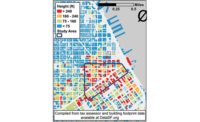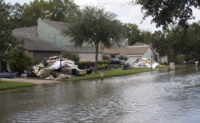Seismic researchers say they have found a number of worrying anomalies in how mid-rise and high-rise buildings with reinforced concrete frames behaved during the 2010 and 2011 earthquakes near Christchurch, New Zealand.
“Many plastic hinge zones in reinforced concrete beams of multistory buildings performed unexpectedly,” says Charles Clifton, associate professor of civil and environmental engineering at the University of Auckland. “It was seen that a few wide cracks developed, rather than the expected large number of hairline cracks.” As a result, the embedded steel reinforcement was subjected to dangerous and excessive localized stress.
The engineer was among several experts presenting research and seeking strategies to make buildings more robust at the New Zealand Society for Earthquake Engineering Technical Conference, held in Rotorua on the North Island April 10-12.
While many of the reinforced concrete buildings damaged by the earthquake remained standing, they stood in a perilous condition. Many have subsequently been demolished, and still more are slated to be torn down.
Clifton and his team replicated the failure mode in the lab, and his findings could have far-reaching implications for future design. “What we wanted to do was to investigate the effect of different loading types and rates on the cracking pattern in the concrete and strain demand along the reinforcing bar within the plastic hinge zone of a typical beam,” he says. “What we found was that the strain along the reinforcing bar was not uniform, and this resulted in concentrated strains developing at crack locations.”
The research shows that the current strategy of repair of damaged concrete buildings is flawed, and needs to be reconsidered due to this markedly nonuniform strain distribution, he says.
“The cracking pattern [we] observed was very similar to that seen in the Christchurch earthquakes,” Clifton adds. “As the longitudinal reinforcing bar is strain-hardened, the strength of the bar in the cracked region increases, which moves the yield further along the reinforcing bar, making it more likely that another crack will form adjacent to the first crack.”
Too Fragile To Demolish
The 7.1-magnitude earthquake in the Canterbury district of the South Island in September 2010 was followed by a shallower and more devastating 6.3-magnitude earthquake in February 2011 that caused vertical ground acceleration of 2.2 g in Christchurch, crumbling many buildings in the Central Business District.
The Clarendon Tower, an 18-story reinforced concrete-framed building designed and constructed in the late 1980s, remained standing—barely. After the quake, it was considered so dangerous that it had to be strengthened before it could be deemed safe for dismantling. The retrofit work was designed by Dunning Thornton of Wellington and Opus International of Christchurch.






Post a comment to this article
Report Abusive Comment